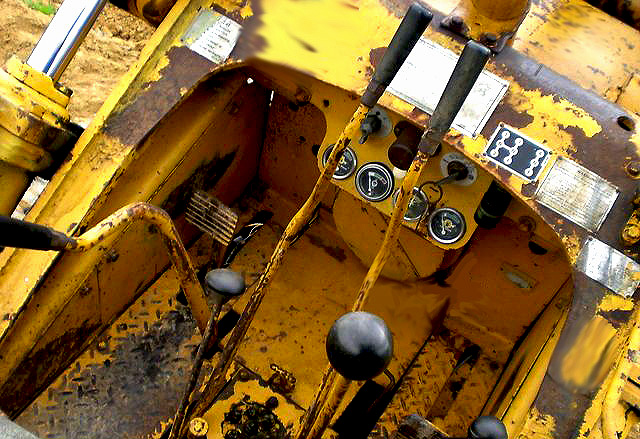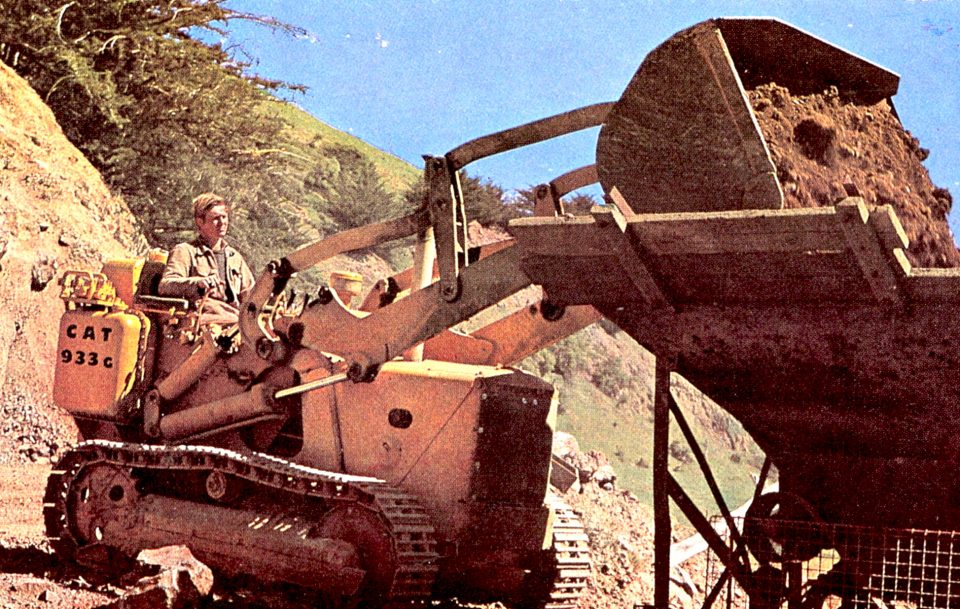Aimed squarely at councils, local bodies and the small owner-operator, Caterpillar’s model 933 track loaders were genuine ‘jack of all trades’ earthmoving machines. Cheap to purchase, they were an ideal first machine for many users. By Richard Campbell.
Above photo: In this photo, taken somewhere in the North Island during the 1960s, a Caterpillar 933G is feeding a grizzly with clay to sift out the rocks. Proximity of the external valve bank near operator’s right elbow would have made things quite warm in summer!
As was the case with quite a few of Caterpillar products, the idea behind its track loader range came from another manufacturer, in this case, Trackson.
That is not to denigrate Caterpillar in any way as its designers obviously knew a good thing when they saw it!
The Trackson Manufacturing Co had been founded in 1922 in Milwaukee, Wisconsin, and had built a respected name in manufacturing attachments for not only Caterpillar, but other machinery manufacturers as well.
Its most popular offerings were front end loader and pipelayer attachments and Caterpillar offered Trackson’s attachments fitted to its D2, D4, D6 and D7 track type tractors under the ‘Caterpillar Traxcavator’ brand name.
Machines so equipped were big sellers for Caterpillar so it was no real surprise when Caterpillar announced its acquisition of Trackson in 1951.
Just prior to the buyout, Trackson had been working on a project whereby the loader frame was an integral part of the track type tractor and not just an add-on component.
The first iteration of this concept was the model HT4 introduced in 1950, which used a wide-gauge Caterpillar D4-7U as the base machine.
This marked a couple of firsts for Trackson as it was the company’s first dedicated track loader and it was also fully hydraulically operated, previous Trackson loaders being cable operated. The HT4 Traxcavator was produced for three years until it was replaced by the subject of this article, the 933.
Caterpillar created an entirely new number series for its new loader product range, the 900 series, and the 933 was the first of three machines in this new range (the others being the 955 and 977).
This first model, the 11A series 933C, was introduced in November 1954 and was powered by a 50 horsepower Caterpillar D311, 4-cylinder naturally aspirated diesel engine with a 4-speed manual transmission.
Nominal bucket capacity was one cubic yard.
Initially, the 933C rode on D2-sized undercarriage but, in service, this was found to be a little bit light for the machine’s intended use, so in 1957 a modification was made on the production line so the machine could use D4-sized undercarriage components.
This modification was made at s/n 11A2596, and Caterpillar called this updated model the 933E.
Approximately 3700 11A series 933C and 933E models were built, all in the USA.
The Caterpillar 933E was manufactured up until 1958 when a further upgraded model, the 933F was introduced.
Considering experience with machines already in service and the problems they had encountered, the new 42A series 933F version was a little more refined than previous models and featured a larger, 1.12 cubic yard bucket.
While horsepower remained the same, a forward/reverse lever was incorporated into the manual transmission to cut down on the number of gear changes the operator had to perform, thereby speeding up cycle times.
The only downside to this innovation was that it added an extra lever to an already “compact” operator’s compartment!

As a response to user requests for more power (an often-heard phrase), Caterpillar made the decision to re-engine the 933 with its new, 4-cylinder, turbocharged model D320T engine that produced 60 flywheel horsepower.
Caterpillar also increased the standard bucket size to 1¼ cubic yards. All of these changes took place at s/n 42A6164 and this new, more powerful machine was known as the 933G and was introduced in 1965.
In production for only three years, the 933G was the last of the 933 lineage and was discontinued in 1968 with some 6900 933F and 933G machines being produced.
The 933F and 933G were manufactured in the USA and as the 25A series in Australia.
A general overview
The 933 series saw widespread use and were very popular with counties, shires, local councils and smaller equipment users and were utilised in all manner of tasks from basement excavation to landfill and smaller logging skid sites.
Reasonably cheap to purchase, own and operate, the 933 could be fitted with a wide range of extra attachments to increase its versatility and the number of tasks it could perform.
However, they were not all that ‘user friendly’ for maintenance staff as their compactness made them difficult to work on.
At the time the last 933G came off the production line, the machine was at the end of its development potential.
Due to the design of the chassis, it was not practicable to fit a powershift transmission without a major redesign, and so the 933 always remained a manual transmission machine.
The narrowness of the operator’s compartment, surrounded by a multitude of levers, made it very labour-intensive workplace, and the author is convinced that most operators were glad when the day’s shift was over.
A successor
When the 933 was discontinued, Caterpillar did not have an immediate replacement sized machine waiting in the wings to fill the now vacant 1¼ cubic yard category. Consequently, there was a 4-year gap until the completely new Caterpillar 931 was introduced in 1972.
These days the role of the small track type loader has been largely taken over by the hydraulic excavator which is far more flexible in its operating envelope.
Models
For those of you who collect models, unfortunately no models in any scale have been produced of the Caterpillar 933 in any of its guises. Because over 10,000 were manufactured this is a little unfortunate and it is to be hoped that some model manufacturer will see its way to correct this oversight.

